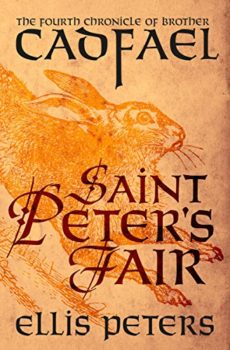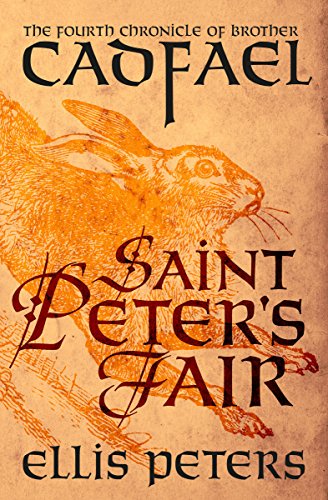
Writing as Ellis Peters, historical novelist Edith Pargeter published twenty-one books in the Cadfael Chronicles from 1977 to 1994. They’re all set in twelfth-century England, spanning the years 1137 to 1145. That was less than a century after the Battle of Hastings (1066), when the island suffered its final invasion of Celtic peoples from mainland Europe. And that history of successive invasions accounts for the seemingly curious diversity of names that crop up in the Brother Cadfael novels. The books’s setting in the county of Shropshire on the border of Wales in southwest England was a melting pot of different ethnicities—a medieval version of today’s fast-blending world. And that diversity leaps off the page in Saint Peter’s Fair, the fourth novel in the series.
Estimated reading time: 4 minutes
A picture of ethnic and linguistic diversity
Consider the names of the principal characters in this story:
- Brother Cadfael
- Abbot Radulphus
- Aline Siward
- Hugh Beringar
- Ivo Corbière
- Philip Corviser
- Gilbert Prestcote
- Emma Vernold
- Rhodri ap Huw
I’m no medieval scholar, but it’s clear to me that these names highlight the ethnic and linguistic diversity of the region. Their origin includes Welsh, Breton, Saxon, and Norman roots. (No doubt Scandinavian influence was also present but no longer reflected in the names common in southwest England.) Clearly, Ms. Pargeter had done her research.
Saint Peter’s Fair (Brother Cadfael #4) by Ellis Peters (1981) 272 pages ★★★★☆
A wealth of historical information
In fact, there’s an abundance of well documented historical information in these beautifully crafted novels:
The annual fair
The eponymous Saint Peter’s Fair is the annual market sponsored by Cadfael’s Benedictine Abbey of Saint Peter and Saint Paul at Shrewsbury. Apparently, the Fair provided a large share of the abbey’s income. Merchants paid the monks the equivalent of tariffs as well as fees to rent the space provided them for the fair. And, as the author makes clear, merchants were happy to pay the price, even though high, because the Fair offered a rare opportunity to sell large quantities of their products to the crowds thronging their booths.
A troubled time in English history
The Cadfael Chronicles are set during a troubled time in English history. King Stephen (reigned 1135-1154) and Empress Maud (also known as Matilda or Maude), representing different factions of nobles, contended for the throne, and their minions wreaked havoc on the land. (She had been Holy Roman Empress from 1114 to 1125, but the novel is set in 1139.) The civil war their rivalry provoked is at the center of the action in Saint Peter’s Fair.
Conflict between town and abbey
The plot in Saint Peter’s Fair hinges in part on the equivalent of a town-gown dispute. The town of Shrewsbury had recently been attacked in the course of the ongoing civil war and suffered considerable damage. The guildsmen who ran the town hoped to persuade the abbot to share a portion of the income from the Fair. Otherwise, they claimed, they couldn’t afford to repair the damage to the town’s walls and streets. But the abbot, citing precedent, refuses, thus setting in motion a series of tragic events.
The dominant monastic order in medieval England
The Benedictines, one of the oldest of the Catholic monastic orders, were dominant in England during the ninth, tenth, eleventh, and twelfth centuries. However, unlike their peers, the Benedictines were not organized in a centralized way; each monastery, priory, or abbey operated autonomously. And although that’s not explicitly noted in Saint Peter’s Fair, it helps explain how the authority exercised by Abbot Radulphus could be so great.
Brother Cadfael: monk, soldier, physician, detective
Like the other books in the Cadfael Chronicles, Saint Peter’s Fair is a mystery, with Brother Cadfael playing the part of a detective. In this tale, he works in tandem with his friend, undersheriff Hugh Beringar. Cadfael had left the life of a soldier in the Crusades sixteen years earlier to join the Benedictines. For all those years, he tended the herb garden and functioned as a physician to the people of Shrewsbury as well as those of the abbey. And, when the dead body of a wealthy merchant turns up on the first day of the three-day Fair, Cadfael and Hugh Beringar feel bound to identify and punish the murderer. Naturally, they will succeed at length, but not before a long, fraught investigation during which other bodies turn up as well.
For related reading
I’ve reviewed all three prior books in the Chronicles of Brother Cadfael:
- A Morbid Taste for Bones (Reviewing the first book in the delightful Brother Cadfael series)
- One Corpse Too Many (Brother Cadfael, the perfect detective for the Middle Ages)
- Monk’s Hood (Has human nature changed since Brother Cadfael’s time?)
You might also enjoy my posts:
- Top 10 mystery and thriller series
- 20 excellent standalone mysteries and thrillers
- 30 outstanding detective series from around the world
- Top 20 suspenseful detective novels
- Top 10 historical mysteries and thrillers
And you can always find my most popular reviews, and the most recent ones, on the Home Page.



























